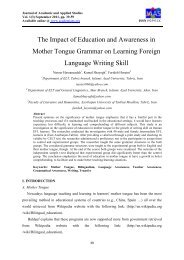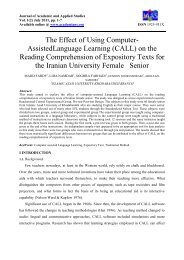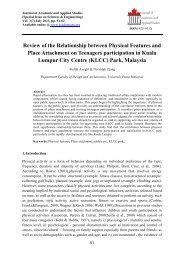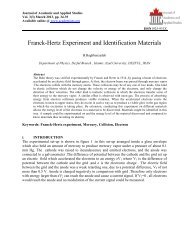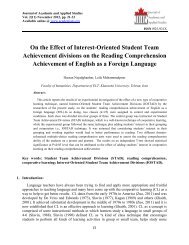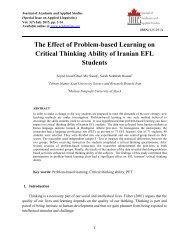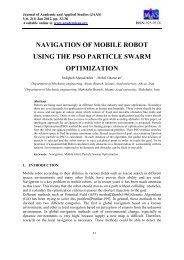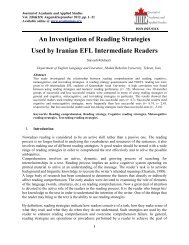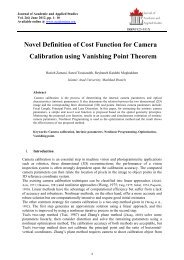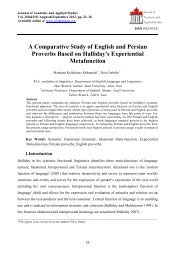New System in Intelligent Transport System by Using Knowledge Grid
New System in Intelligent Transport System by Using Knowledge Grid
New System in Intelligent Transport System by Using Knowledge Grid
You also want an ePaper? Increase the reach of your titles
YUMPU automatically turns print PDFs into web optimized ePapers that Google loves.
Journal of Academic and Applied Studies<br />
Vol. 2(3) March 2012, pp. 15-24<br />
Available onl<strong>in</strong>e @ www.academians.org<br />
ISSN1925-931X<br />
<strong>New</strong> <strong>System</strong> <strong>in</strong> <strong>Intelligent</strong> <strong>Transport</strong> <strong>System</strong> <strong>by</strong><br />
Us<strong>in</strong>g <strong>Knowledge</strong> <strong>Grid</strong><br />
Beh<strong>in</strong> Alipour<br />
Dept. computer Eng. Tabriz Branch, Islamic Azad university, Tabriz, Iran<br />
ABSTRACT<br />
Vehicle communications is special attentions of academics and <strong>in</strong>dustrials <strong>in</strong> recent years and the <strong>in</strong>telligent<br />
transport system (ITS) and the related technologies developed. After the extension of different and various<br />
vehicle technologies that uses <strong>in</strong> navigation, management, anti-theft protections, traffic <strong>in</strong>formation and the<br />
active roadside signs, the vehicle communications created. In this paper review exist<strong>in</strong>g ITS methods and<br />
discuss on improvements and reduce restrictions of them. We purpose a new hybrid system that try<strong>in</strong>g to<br />
improve the current systems and reduce their limitation <strong>by</strong> us<strong>in</strong>g <strong>Grid</strong> knowledge.<br />
Key words: <strong>Intelligent</strong> <strong>Transport</strong> <strong>System</strong>, Inter Vehicle Communication, VANET, Cloud comput<strong>in</strong>g, Inter<br />
Cloud, <strong>Knowledge</strong> <strong>Grid</strong>, Relational knowledge<br />
INTRODUCTION<br />
With the community development, develop<strong>in</strong>g and <strong>in</strong> progress countries are fac<strong>in</strong>g with the<br />
common but important and considerable problems. Traffic congestion <strong>in</strong>creas<strong>in</strong>g seriously and<br />
the accidents occur much more than common. Accord<strong>in</strong>g to statistics taken <strong>in</strong> different regions<br />
of the world millions of <strong>in</strong>jured and died <strong>in</strong> highways and roads of the world occurs annually,<br />
traffic density have wasted a significant amount of time and fuel. All these problems are grow<strong>in</strong>g<br />
as a major obstacle for the development of societies. To solve these problems not require a return<br />
to us<strong>in</strong>g horses and carts but <strong>by</strong> provid<strong>in</strong>g relevant <strong>in</strong>formation to the vehicle or drivers has been<br />
solved. Therefore it makes roads safer and more efficient for drivers and lower costs to<br />
governments. <strong>Intelligent</strong> traffic systems (ITS), sometimes called <strong>in</strong>telligent transportation<br />
systems, apply communications and <strong>in</strong>formation technology to manage traffic flow, encourage<br />
drivers to use alternate forms of transport, and enable people to f<strong>in</strong>d the services and <strong>in</strong>formation<br />
which they need to drive safely, avoid traffic jams, and perform their daily rout<strong>in</strong>e with fewer<br />
hassles and with more peace of m<strong>in</strong>d. The necessity of the avoid<strong>in</strong>g traffic congestion, accidents<br />
and the dangers that they are creat<strong>in</strong>g, caused sav<strong>in</strong>g much time, fuel and the large capital be<br />
restored. Vehicle Ad-hoc Network (VANET) is promis<strong>in</strong>g a technology which will provide<br />
safety aspects of road, Public and private services that <strong>in</strong>crease of the security and comfort for<br />
passengers will be capable [1]. This application are requires a communication model for their<br />
development. Previous study [2],[3] is divided vehicle communications to vehicle to<br />
Infrastructure (V2I/I2V) and vehicle to vehicle (V2V), which is visible <strong>in</strong> (Figure.1). Both of<br />
communication requires a secure and reliable configuration for establish<strong>in</strong>g and ma<strong>in</strong>ta<strong>in</strong><strong>in</strong>g<br />
security of f<strong>in</strong>al consumers (vehicles). VANET is an example of mobile network that is created<br />
15
Journal of Academic and Applied Studies<br />
Vol. 2(3) March 2012, pp. 15-24<br />
Available onl<strong>in</strong>e @ www.academians.org<br />
ISSN1925-931X<br />
for communication between near<strong>by</strong> vehicles (IVC: Inter Vehicle communication) and also<br />
vehicles with fixed equipment near<strong>by</strong> (RVC: Roadside to Vehicle communication) which usually<br />
are roadside equipment [4]. The ma<strong>in</strong> purpose of VANET is provid<strong>in</strong>g security and comfort for<br />
passengers. To reach this goal a particular electronic device embedded <strong>in</strong> each vehicle to<br />
established ad-hoc communication. It is clear that the network should be implemented without<br />
structure limitations of client - server network communication. Each vehicle equipped with a<br />
device can receive and send messages to others via the wireless network like a network node.<br />
Road’s traffic signs and observes that can transmit through such a network each moment, which<br />
provide the necessary tools for choos<strong>in</strong>g the best path <strong>by</strong> the driver. Also the Multimedia<br />
Communications and wireless Internet <strong>in</strong> every vehicle will be provided. Automatic payment of<br />
road side costs and park<strong>in</strong>g costs is example of the other Vanet applications. InVanet or<br />
<strong>Intelligent</strong> VANET actually is a <strong>Intelligent</strong> technique <strong>in</strong> networks between vehicles that<br />
<strong>in</strong>tegration several classification of ad-hoc network technologies such as WiFi IEEE 802.11blg,<br />
WiMAX IEEE802.16, Bluetooth, IRA, and ZigBee to provide the communicate easily,<br />
accurately and effectively between the vehicles <strong>in</strong> the wireless environment. This type of<br />
network uses the available communication technology such as DSRC (Dedicated Short Range<br />
Communication) which is actually k<strong>in</strong>d of WiFi, cellular and satellite communications [14],[15].<br />
In this paper types of exist<strong>in</strong>g ITS methods is proposed. With the reviews, compare of<br />
improvements, reduce restrictions of them and look<strong>in</strong>g at the future of ITS, a comb<strong>in</strong>ation<br />
approach is considered.<br />
I. ITS systems<br />
This section will be review<strong>in</strong>g the ITS systems and projects and their advantage and<br />
disadvantage. At first expla<strong>in</strong> traditional ITS and some example projects. In the second part ITS<br />
system based on <strong>in</strong>ter-vehicle system that is decentralized system and <strong>in</strong> the third part hybrids<br />
systems that is us<strong>in</strong>g <strong>Grid</strong> comput<strong>in</strong>g and f<strong>in</strong>ally a system that us<strong>in</strong>g <strong>Knowledge</strong> grid are<br />
discusses.<br />
A. Traditional ITS<br />
A series of project based on traditional ITS <strong>in</strong> several countries are runn<strong>in</strong>g and test<strong>in</strong>g<br />
1. TravTek: In America <strong>in</strong> 2005 under the Traffic Equity Act of 21st Century (TEA-21)<br />
framework, proposed the project <strong>in</strong>cludes TravTek. This system has three basic part:<br />
TISC: Traffic Information Service Center<br />
TMC: Traffic Management <strong>System</strong><br />
TravTek vehicles<br />
Functions such as navigation <strong>in</strong>formation, route guidance, real-time traffic <strong>in</strong>formation and<br />
<strong>in</strong>formation on local services are available <strong>in</strong> the vehicles [5].<br />
2. VICS (Vehicle Information & Communication <strong>System</strong>): In Japan <strong>in</strong> 2005,VICS is one of the<br />
most successful ITS projects. It have an ability to provide real-time <strong>in</strong>formation for drivers of<br />
traffic conditions via the FM multiple broadcast<strong>in</strong>g, radio waves, signs and optical beacons [6].<br />
16
Journal of Academic and Applied Studies<br />
Vol. 2(3) March 2012, pp. 15-24<br />
Available onl<strong>in</strong>e @ www.academians.org<br />
ISSN1925-931X<br />
Technically VICS is sometimes like TravTek. Both of the projects unable to collect and process<br />
large amounts traffic data and not provid<strong>in</strong>g any value-added services, only can broadcast<strong>in</strong>g<br />
traffic <strong>in</strong>formation through radio.<br />
3. Trafficmaster: In 2005, <strong>in</strong> Europe, established a technical group that focuses on the satellite<br />
navigation system and digital traffic <strong>in</strong>formation service. In trafficmaster Radio Data<br />
<strong>System</strong>_Traffic Message Channel (RDS_TMC) service broadcast<strong>in</strong>g traffic data over the RDS<br />
sub-carrier on FM radio which can be used <strong>by</strong> the satellite navigation system to provide dynamic<br />
rout<strong>in</strong>gs. Orig<strong>in</strong>ally it is just a k<strong>in</strong>d of advanced Global Position <strong>System</strong> (GPS) and can only<br />
provide solitary services [7].<br />
4. Limitation of traditional ITS:<br />
ITS projects have showed their benefits for solv<strong>in</strong>g traffic problems, but two limits have<br />
rema<strong>in</strong>ed that prevent them from provid<strong>in</strong>g better services. Lack of high performance comput<strong>in</strong>g<br />
platform, unable to provide process<strong>in</strong>g and <strong>in</strong>tegrat<strong>in</strong>g massive multi-sensor data that cause realtime<br />
on-demand traffic services can hardly be provided. Possible solution to resolve this is us<strong>in</strong>g<br />
of emerg<strong>in</strong>g advance <strong>in</strong>formation technology means grid technology. In the experimental system<br />
Urban Traffic Information Service Application <strong>Grid</strong> (UTISAG), efficiency and effectiveness <strong>in</strong><br />
deal<strong>in</strong>g with data traffic has been study. The second limitation, they are usually organized <strong>in</strong> a<br />
centralistic way as well as UTISAG. Multi-sensor data traffic <strong>in</strong>itially are transmitted to Traffic<br />
Information Centre (TIC: Traffic Information Center) then they are analyzed until traffic<br />
<strong>in</strong>formation acquire or TIC sent them to other comput<strong>in</strong>g platforms for more process<strong>in</strong>g. F<strong>in</strong>ally,<br />
traffic <strong>in</strong>formation is broadcasted to all drivers via the RDS or accord<strong>in</strong>g to requests will be<br />
transferred through the wireless <strong>in</strong>frastructure network. The centralized service method has<br />
several disadvantages:<br />
Hot spot problem: A great deal of traffic sensor data and request needs to be processed <strong>by</strong><br />
a TIC meanwhile massive data needs to be communicated between TIC and millions of<br />
users. Too much comput<strong>in</strong>g, storage and communication capacity is demanded for TIC.<br />
As a result, the TIC is overloaded and congested soon, and the performance of the ITS is<br />
then deteriorated.<br />
It is not suitable for security applications of V2V (Vehicle to Vehicle), which require<br />
rapid exchange of <strong>in</strong>formation between the vehicles.<br />
High operational costs.<br />
B. The system based on <strong>in</strong>ter-vehicle communication networks<br />
To solve the problems the system based on Inter vehicle communication (IVC) networks may<br />
provide a decentralized solution and alleviate the problem to a great extent [4],[8]. IVC networks<br />
are an <strong>in</strong>stantiation of a mobile ad-hoc network (MANET), however, have its unique<br />
characteristics and challenges. IVC characteristics compared with MANET:<br />
Rapid topology changes: Because of the high relative speed of vehicles, the IVC network<br />
experiences very rapid changes <strong>in</strong> topology.<br />
Frequent fragmentation: Due to the low deployment of vehicles hav<strong>in</strong>g IVC, The IVC<br />
network will be subject to frequent fragmentation.<br />
17
Journal of Academic and Applied Studies<br />
Vol. 2(3) March 2012, pp. 15-24<br />
Available onl<strong>in</strong>e @ www.academians.org<br />
ISSN1925-931X<br />
Small effective network diameter: Due to weak communications, network diameter and<br />
range of <strong>in</strong>fluence is really bad.<br />
Predictable topology changes: Vehicle usually moved along the pre-built roads. Thus,<br />
given the average speed, current position, and road topology, the future position of a<br />
vehicle can be predicted.<br />
There are various projects based on IVC. FleetNet, about develop<strong>in</strong>g an IVC network tries to<br />
improve the comfort and safety of passengers and the drivers [9]. V<strong>Grid</strong>, was <strong>in</strong>troduced to<br />
solved the vehicle traffic flow control problem autonomously [10]. TrafficView, def<strong>in</strong>es a<br />
framework to dissem<strong>in</strong>ate and gather <strong>in</strong>formation about the vehicles on the road based on IVC.<br />
AutoNet, Ad-hoc Peer to Peer <strong>in</strong>formation <strong>in</strong>tends to atta<strong>in</strong> a comprehensive distributed<br />
transportation management system [11]. ACAHS reduce traffic accidents, <strong>in</strong>crease safety,<br />
improve efficiency and reduce the complexity of transportation for drivers. AHS, exam<strong>in</strong>es how<br />
the vehicle technology can automatically be used to quell traffic congestion [12]. Entitled Zero-<br />
Information, to <strong>in</strong>troduce and study a completely decentralized traffic <strong>in</strong>formation system based<br />
on data exchange only <strong>by</strong> equipped vehicle and does not need any <strong>in</strong>frastructure support [13].<br />
The system completely based on <strong>in</strong>ter-vehicle communication also has its limits:<br />
The vehicle lacks great capacity of comput<strong>in</strong>g and storage, so complicated traffic<br />
<strong>in</strong>formation process<strong>in</strong>g is hard to carry out.<br />
<br />
<br />
Vehicles can’t be a general overview of the situation is the network path.<br />
Some of the essential services are not supported. The present ITS based on IVC ma<strong>in</strong>ly<br />
focuses on provid<strong>in</strong>g the service of neighbor<strong>in</strong>g route status, some other important<br />
services such as urgent regional traffic control messages are not supported.<br />
C. ITC hybrid systems and <strong>Grid</strong> Comput<strong>in</strong>g (<strong>Grid</strong> comput<strong>in</strong>g)<br />
1. VGITS system<br />
Other proposed ITS systems that use <strong>Grid</strong> Comput<strong>in</strong>g technology is called VGITS (Vehicle <strong>Grid</strong><br />
ITS) [14]. This system has hybrid architecture. The vehicles have IVC networks. In the IVC<br />
networks, vehicles send GPS data of their own, and meanwhile receive other vehicles’ GPS data.<br />
Then <strong>by</strong> analyz<strong>in</strong>g these data, some<br />
important traffic services are provided<br />
to drivers. At most<br />
cases, these services<br />
can satisfy drivers and<br />
if necessary, vehicles<br />
can also sent their request to traffic<br />
center for more operation. This unit<br />
provided the services<br />
<strong>by</strong> pack<strong>in</strong>g massive<br />
traffic data and send<strong>in</strong>g them to grid<br />
nodes for further process<strong>in</strong>g. <strong>Grid</strong><br />
technology has been<br />
<strong>in</strong>troduced to provide<br />
high performance to<br />
execute large traffic<br />
data and exist<strong>in</strong>g real-<br />
time traffic services.<br />
IVC comput<strong>in</strong>g and<br />
communication<br />
18
Journal of Academic and Applied Studies<br />
Vol. 2(3) March 2012, pp. 15-24<br />
Available onl<strong>in</strong>e @ www.academians.org<br />
ISSN1925-931X<br />
capabilities developed to provide decentralized traffic services for drivers. In this system, the<br />
system computational load is <strong>in</strong> balance with the grid nodes and <strong>in</strong>-vehicle term<strong>in</strong>als and better<br />
performance is achieved. VGITS configuration and its resources are shown <strong>in</strong> Figure 1.<br />
Fig 1: VGITS framework.<br />
2. <strong>System</strong> architecture and function<br />
In accordance with traffic system requirements, VGITS architecture is divided <strong>in</strong>to four layers as<br />
follow:<br />
Service on-demand and presentation layer<br />
This layer provides some <strong>in</strong>terfaces of on-demand services for users. There are two users<br />
<strong>in</strong> VGITS, TIC adm<strong>in</strong>istrators and drivers. The TIC adm<strong>in</strong>istrators can manage the<br />
request traffic services via web browser. For the response to Drivers, specific application<br />
software is <strong>in</strong>stalled on the vehicles.<br />
Application service layer<br />
This layer divided the traffic services application <strong>in</strong> to two categories. The first group<br />
ma<strong>in</strong>ly consists of traffic management services, simulation of a regional hybrid traffic<br />
flow, Dynamic route status service, Public facility <strong>in</strong>quiry service and optimum dynamic<br />
travel scheme service that have been considered for ITC manager. The second group is<br />
the Traffic services for drivers that ma<strong>in</strong>ly <strong>in</strong>clude neighbor route status service and safe<br />
warn<strong>in</strong>g service.<br />
Service support layer<br />
In order to support application service layer, this layer not only provides complex grid<br />
comput<strong>in</strong>g-based services such as grid task schedul<strong>in</strong>g, data management, but also<br />
provides relatively simple IVC comput<strong>in</strong>g-based services such as <strong>in</strong>-vehicle comput<strong>in</strong>g<br />
resource management, GPS data management, etc.<br />
Resource layer<br />
19
Journal of Academic and Applied Studies<br />
Vol. 2(3) March 2012, pp. 15-24<br />
Available onl<strong>in</strong>e @ www.academians.org<br />
ISSN1925-931X<br />
In this layer, there are storage devices, computers and necessary software which required<br />
<strong>by</strong> the <strong>Grid</strong> nodes and IVC. Also, valuable resources for support any communication<br />
traffic service is required.<br />
3. V<strong>Grid</strong> system<br />
There is another example of the use of <strong>Grid</strong> Comput<strong>in</strong>g technology <strong>in</strong> the vehicular network<br />
which is different from proposed systems. In this case, a new configuration that use the vehicle<br />
to vehicle communications and distributed comput<strong>in</strong>g can use as a platform for some services<br />
such as traffic control, user <strong>in</strong>fota<strong>in</strong>ment application and <strong>in</strong>ternet services. With the <strong>in</strong>creases of<br />
data density, computational resources that means vehicle are naturally <strong>in</strong>creased and the system<br />
will not be <strong>in</strong> trouble. Accident warn<strong>in</strong>g and speed limit variables (VLS) are two important<br />
applications of this system that cause V<strong>Grid</strong> could improve driver’s safety and traffic flow<br />
smooth<strong>in</strong>g. [15]<br />
D. ITC system with knowledge <strong>Grid</strong><br />
As the research process shows, limitations of ITS has been gradually more pale but still some<br />
restrictions rema<strong>in</strong>ed that make us to resolve them or make them less. One of the limitations of<br />
ITS is the lack of overall control and access <strong>in</strong> vehicles. At first, Dom<strong>in</strong>ance was at the<br />
neighbor's routes and then <strong>in</strong>creased. This advantage is also ideal for drivers and managers<br />
because they can analyze the comparative works and the statistics works simply and more<br />
accurate than before. Our system will not have the limitation of storage capacity, calculation and<br />
communication routes.<br />
So <strong>in</strong> addition to support the past services, answer<strong>in</strong>g can be extended to the further and future<br />
requests. The proposed scheme which reduce the more restrictions is us<strong>in</strong>g of <strong>Grid</strong> technology<br />
more than the previous schemes. So that the management and <strong>in</strong>tegrat<strong>in</strong>g of traffic control<br />
centers will be perform through <strong>Knowledge</strong> <strong>Grid</strong> [15]. In this section, at first system structures<br />
and then relation formation and knowledge evolution will be checked.<br />
1. <strong>System</strong> structure and configuration<br />
The system operation is shown as a flowchart <strong>in</strong> Figure 2. For better coverage of receiv<strong>in</strong>g traffic<br />
<strong>in</strong>formation roadside equipments, sensors, etc have been <strong>in</strong>stalled. For avoidance of traditional<br />
ITS limitation the IVC network will be exist so that it will accountable a series of on-demand<br />
service, except that result of the calculations will be send to both, the vehicle and control centers.<br />
20
Journal of Academic and Applied Studies<br />
Vol. 2(3) March 2012, pp. 15-24<br />
Available onl<strong>in</strong>e @ www.academians.org<br />
ISSN1925-931X<br />
Fig 2: <strong>System</strong> flowchart<br />
Other services that IVC cannot response them (because of their limitation) will be send to control<br />
center. Control center packed the requests and send them to <strong>Grid</strong> nodes which are provider of<br />
computational capacity and storage of control center, then the results after process<strong>in</strong>g resend to<br />
the center control. Traffic control centers <strong>in</strong> each city is subsidiaries of the country's traffic<br />
control center and <strong>in</strong>formation will be send to the database of country traffic center and at the<br />
same time will archive <strong>in</strong> database (For more cautiously and accord<strong>in</strong>g to the needs, the history<br />
of the Urban Traffic Control Center are stored). Each country's traffic control centers are<br />
connected together <strong>by</strong> us<strong>in</strong>g the <strong>Knowledge</strong> <strong>Grid</strong> environment. In this mode, once the send<strong>in</strong>g<br />
<strong>in</strong>formation from city's traffic control centers to country's traffic control center this data <strong>in</strong> grid<br />
application have been updated <strong>in</strong> environment that <strong>Grid</strong> make it possible and with us<strong>in</strong>g the<br />
related graphic supported these data becomes the graphic map. This map is global and as soon as<br />
the traffic <strong>in</strong>formation post will be updated. It will be supported all features and route of roads.<br />
Above all, requester does not need to be<strong>in</strong>g closed the desire path and he has a global<br />
dom<strong>in</strong>ation. Then, accord<strong>in</strong>g to the required grid software and graphic <strong>in</strong>terfaces which have<br />
been <strong>in</strong>stalled on each vehicle, access<strong>in</strong>g to this map is possible <strong>in</strong> the vehicles. This map creates<br />
a global view of all road surfaces and paths. It should be noted that the implemented of smallerscale<br />
size of this scheme <strong>in</strong> the country area is possible. The result, a graphical map of the<br />
21
Journal of Academic and Applied Studies<br />
Vol. 2(3) March 2012, pp. 15-24<br />
Available onl<strong>in</strong>e @ www.academians.org<br />
ISSN1925-931X<br />
national traffic road that will be coverage all cities and roads surfaces. The total structure of<br />
system is shown <strong>in</strong> figure3.<br />
Fig 3: <strong>System</strong> framework<br />
2. Relation formation and knowledge evolution<br />
As was said, this system for access the maximum utilization from available <strong>in</strong>formation and<br />
more accurate conclusions and less cost, us<strong>in</strong>g <strong>Grid</strong> knowledge [16]. As shown <strong>in</strong> figure 4,<br />
sensors, camera reported, satellite support<strong>in</strong>g and experts analysis makes our receiv<strong>in</strong>g<br />
<strong>in</strong>formation resources. This unit update itself <strong>by</strong> relation <strong>in</strong> owns. The relational knowledge part<br />
and Problem-solv<strong>in</strong>g knowledge part cooperation together with complete and expla<strong>in</strong> the data.<br />
Also the receiv<strong>in</strong>g data resources unit cooperated to Problem-solv<strong>in</strong>g unit with question<strong>in</strong>g and<br />
answer<strong>in</strong>g.<br />
These three units with their cooperation can access the desire knowledge. The tags part do<br />
especial and related <strong>in</strong>dexed such as <strong>in</strong>dex<strong>in</strong>g statistical, <strong>in</strong>dex<strong>in</strong>g comparison, <strong>in</strong>dex<strong>in</strong>g distance,<br />
<strong>in</strong>dex<strong>in</strong>g time and etc. The unit name mega <strong>in</strong>formation consist of static structures <strong>in</strong> the system<br />
body such as roads, static signs, tolls, bridges and etc. This part updated itself and when<br />
exchanges <strong>in</strong>fluence system. All these parts cause the content to be produced. The knowledge<br />
that produced <strong>in</strong> the content part is used <strong>by</strong> user part. Content outputs with graphical support<br />
produce the dynamic onl<strong>in</strong>e map and accord<strong>in</strong>g to related request, traffic services, security,<br />
healthy services and etc can be supported <strong>in</strong> the vehicles and other user nodes [16].<br />
22
Journal of Academic and Applied Studies<br />
Vol. 2(3) March 2012, pp. 15-24<br />
Available onl<strong>in</strong>e @ www.academians.org<br />
ISSN1925-931X<br />
Fig 4: Relation formation and knowledge<br />
evolution of system<br />
CONCLUSION<br />
Because of the importance of communication and driver's need to become aware about road’s<br />
near or far conditions to avoid undesirable conditions such as collision and road density which<br />
waste the time and cost, the <strong>in</strong>telligent transport system considered. In this paper, development<br />
trend of ITS systems types from past to present along their characteristics were <strong>in</strong>vestigated<br />
And the scheme was proposed that tak<strong>in</strong>g advantage of the <strong>Grid</strong> technology causes to less<br />
restrictions will be available. That Result<strong>in</strong>g <strong>in</strong> improved performance and more ease of access<br />
to the ITS services.<br />
REFERENCE<br />
[1] Hannes Hartenste<strong>in</strong>, Kenneth P. Laberteaux, 2008 ieee A Tutorial Survey on Vehicular Ad<br />
Hoc Networks<br />
[2] P. Papadimitratos, A. Kung, J. Hubaux, and F. Kargl. (July, 2006.) Privacy and identity<br />
management for vehicular communication systems: a position paper.In Proceed<strong>in</strong>gs of<br />
Workshop on Standards for Privacy <strong>in</strong> User-Centric Identity Management, Zurich,<br />
Switzerland.<br />
[3] M. Raya and J. Hubaux. The security of vehicular networks.( 2005). Proceed<strong>in</strong>gs of the<br />
3rdACM workshop on Security of Ad hoc and Sensor Networks(SASN 2005), pages 11–21.<br />
23
Journal of Academic and Applied Studies<br />
Vol. 2(3) March 2012, pp. 15-24<br />
Available onl<strong>in</strong>e @ www.academians.org<br />
ISSN1925-931X<br />
[4] Mihail L. Sichitu, Maria Kihil, 2008 IEEE Communications Surveys & Tutorials , INTER<br />
-VEHICLE COMMUNICATION SYSTEMS:A SURVEY<br />
[5]TravTek.http://www.fhwa.dot.gov/tfhrc/safety/pubs/95197/sec3/sec3_01.html.<br />
[6] VICS. R. B.( 2005). ITS, “Japanese m<strong>in</strong>istry of land, <strong>in</strong>frastructure and<br />
transport.”http://www.its.go.jp/ITS/<strong>in</strong>dex.htmlhttp://www.tele.soumu.go.jp/e/system/ml/its/<strong>in</strong><br />
dex.htm,<br />
[7]Trafficmaster.(2005).http://www.trafficmaster.co.uk/page.cfm?key=RDS_TMC. 2005<br />
[8]Ra<strong>in</strong>er Baumann. (2004). Vehicular Ad hoc Networks (VANET)Master’s<br />
Thesis:(Eng<strong>in</strong>eer<strong>in</strong>g and simulation of mobile ad hoc rout<strong>in</strong>g protocols for VANET on<br />
highways and <strong>in</strong>cities), Master’s Thesis <strong>in</strong> Computer Science, ETH Zurich<br />
[9] FleetNet.http://www.fleetnet.co.uk,2003<br />
[10] Joey Anda1, Jason LeBrun2, Dipak Ghosal, Chen-Nee Chuah, Michael Zhang,<br />
University ofCalifornia at Davis, V<strong>Grid</strong>: Vehicular AdHoc Network<strong>in</strong>g and Comput<strong>in</strong>g <strong>Grid</strong><br />
for <strong>Intelligent</strong>Traffic Control, California USA<br />
[11] “Autonet: Ad hoc peer to peer <strong>in</strong>formation technology for traffic networks.”<br />
(2005).http://www.its.uci.edu/ mcnally/mgm-autonet.html<br />
[12] AHS U. Berkeley, “Partners for advanced transit and highways (path).” http://wwwpath.eecs.berkeley.edu/.<br />
[13] “A zero <strong>in</strong>frastructure traffic <strong>in</strong>formation system.”<br />
http://trans.civil.northwestern.edu/thanasis/ research/projects/zi.html.<br />
[14] L<strong>in</strong> Chen, Changjun Jiang, Junjie Li (2006) Elsevier, “VGITS: ITS based on <strong>in</strong>tervehicle<br />
communication networks and grid technology”.<br />
[15] Andrew Chen, Behrooz Khorashadi, Chen-Nee Chuah, Dipak Ghosal, and<br />
MichaelZhang,(2006) IEEE, “Smooth<strong>in</strong>g Vehicular Traffic Flow us<strong>in</strong>g Vehicular-based Ad<br />
Hoc Network<strong>in</strong>g &Comput<strong>in</strong>g <strong>Grid</strong> (V<strong>Grid</strong>)” .<br />
[16] Hai Zhuge, 2008 IEEE, The <strong>Knowledge</strong> <strong>Grid</strong> Environment.<br />
24



